Instance Segmentation with Mask R-CNN and TensorFlow
Back in November, we open-sourced our implementation of Mask R-CNN, and since then it’s been forked 1400 times, used in a lot of projects, and improved upon by many generous contributors. We received a lot of questions as well, so in this post I’ll explain how the model works and show how to use it in a real application.
I’ll cover two things: First, an overview of Mask RCNN. And, second, how to train a model from scratch and use it to build a smart color splash filter.
Code Tip:
We’re sharing the code here. Including the dataset I built and the trained model. Follow along!
What is Instance Segmentation?
Instance segmentation is the task of identifying object outlines at the pixel level. Compared to similar computer vision tasks, it’s one of the hardest possible vision tasks. Consider the following asks:
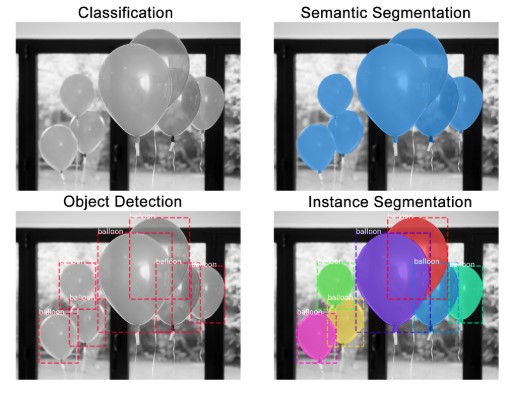
- Classification: There is a balloon in this image.
- Semantic Segmentation: These are all the balloon pixels.
- Object Detection: There are 7 balloons in this image at these locations. We’re starting to account for objects that overlap.
- Instance Segmentation: There are 7 balloons at these locations, and these are the pixels that belong to each one.
Mask R-CNN
Mask R-CNN (regional convolutional neural network) is a two stage framework: the first stage scans the image and generates proposals(areas likely to contain an object). And the second stage classifies the proposals and generates bounding boxes and masks.
It was introduced last year via the Mask R-CNN paper to extend its predecessor, Faster R-CNN, by the same authors. Faster R-CNN is a popular framework for object detection, and Mask R-CNN extends it with instance segmentation, among other things.
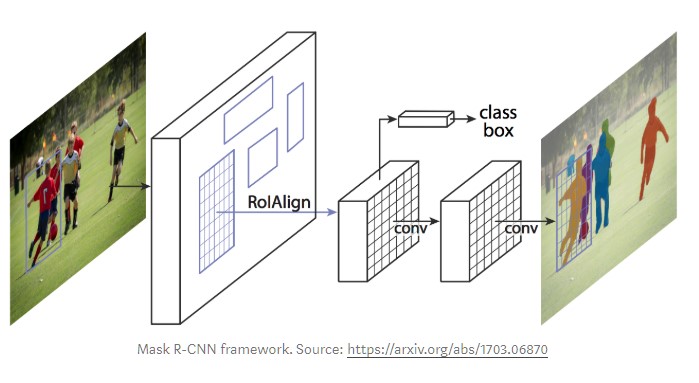
At a high level, Mask R-CNN consists of these modules:
1. Backbone
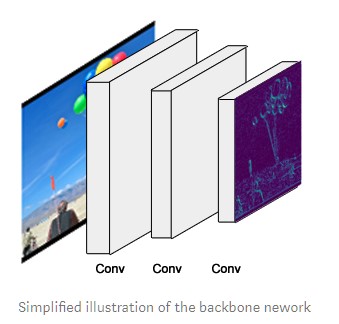
This is a standard convolutional neural network (typically, ResNet50 or ResNet101) that serves as a feature extractor. The early layers detect low level features (edges and corners), and later layers successively detect higher level features (car, person, sky).
Passing through the backbone network, the image is converted from 1024x1024px x 3 (RGB) to a feature map of shape 32x32x2048. This feature map becomes the input for the following stages.
Code Tip:
The backbone is built in the function resnet_graph(). The code supports ResNet50 and ResNet101.
Feature Pyramid Network
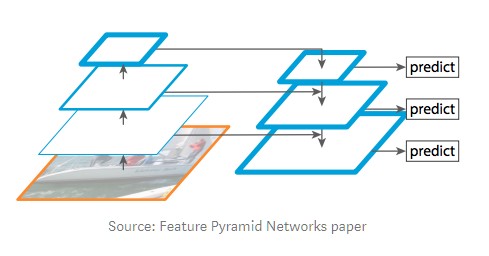
While the backbone described above works great, it can be improved upon. The Feature Pyramid Network (FPN) was introduced by the same authors of Mask R-CNN as an extension that can better represent objects at multiple scales.
FPN improves the standard feature extraction pyramid by adding a second pyramid that takes the high level features from the first pyramid and passes them down to lower layers. By doing so, it allows features at every level to have access to both, lower and higher level features.
Our implementation of Mask RCNN uses a ResNet101 + FPN backbone.
Code Tip:
The FPN is created in MaskRCNN.build(). The section after building the ResNet.
RPN introduces additional complexity: rather than a single backbone feature map in the standard backbone (i.e. the top layer of the first pyramid), in FPN there is a feature map at each level of the second pyramid. We pick which to use dynamically depending on the size of the object. I’ll continue to refer to the backbone feature map as if it’s one feature map, but keep in mind that when using FPN, we’re actually picking one out of several at runtime.
2. Region Proposal Network (RPN)
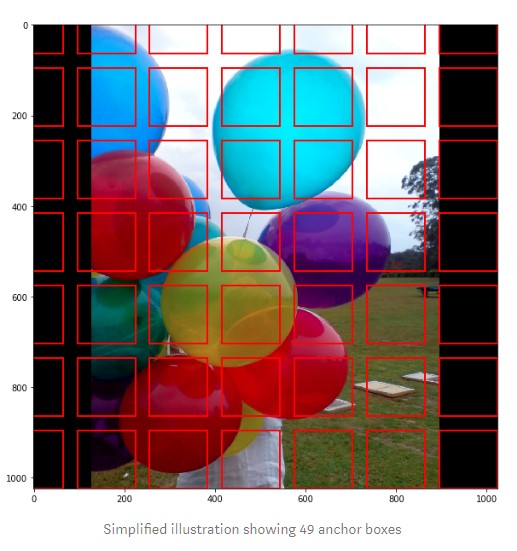
The RPN is a lightweight neural network that scans the image in a sliding-window fashion and finds areas that contain objects.
The regions that the RPN scans over are called anchors. Which are boxes distributed over the image area, as show on the left. This is a simplified view, though. In practice, there are about 200K anchors of different sizes and aspect ratios, and they overlap to cover as much of the image as possible.
How fast can the RPN scan that many anchors? Pretty fast, actually. The sliding window is handled by the convolutional nature of the RPN, which allows it to scan all regions in parallel (on a GPU). Further, the RPN doesn’t scan over the image directly (even though we draw the anchors on the image for illustration). Instead, the RPN scans over the backbone feature map. This allows the RPN to reuse the extracted features efficiently and avoid duplicate calculations. With these optimizations, the RPN runs in about 10 ms according to the Faster RCNN paper that introduced it. In Mask RCNN we typically use larger images and more anchors, so it might take a bit longer.
Code Tip:
The RPN is created in rpn_graph(). Anchor scales and aspect ratios are controlled by RPN_ANCHOR_SCALES and RPN_ANCHOR_RATIOS in config.py.
The RPN generates two outputs for each anchor:
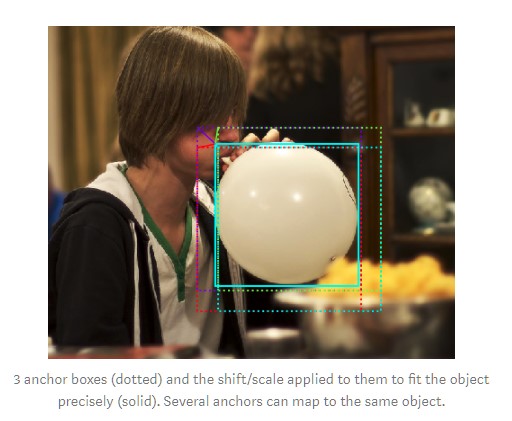
- Anchor Class: One of two classes: foreground or background. The FG class implies that there is likely an object in that box.
- Bounding Box Refinement: A foreground anchor (also called positive anchor) might not be centered perfectly over the object. So the RPN estimates a delta (% change in x, y, width, height) to refine the anchor box to fit the object better.
Using the RPN predictions, we pick the top anchors that are likely to contain objects and refine their location and size. If several anchors overlap too much, we keep the one with the highest foreground score and discard the rest (referred to as Non-max Suppression). After that we have the final proposals (regions of interest) that we pass to the next stage.
Code Tip:
The ProposalLayer is a custom Keras layer that reads the output of the RPN, picks top anchors, and applies bounding box refinement.
3. ROI Classifier & Bounding Box Regressor
This stage runs on the regions of interest (ROIs) proposed by the RPN. And just like the RPN, it generates two outputs for each ROI:
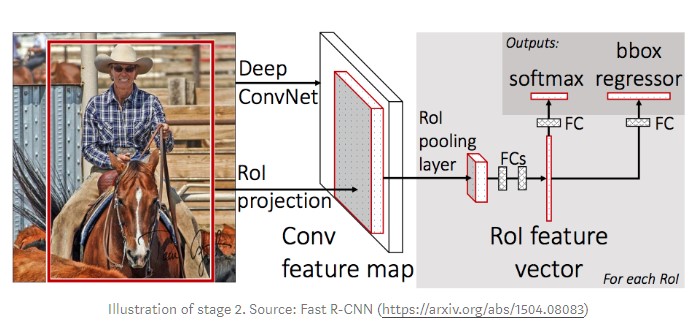
- Class: The class of the object in the ROI. Unlike the RPN, which has two classes (FG/BG), this network is deeper and has the capacity to classify regions to specific classes (person, car, chair, …etc.). It can also generate a background class, which causes the ROI to be discarded.
- Bounding Box Refinement: Very similar to how it’s done in the RPN, and its purpose is to further refine the location and size of the bounding box to encapsulate the object.
Code Tip:
The classifier and bounding box regressor are created in fpn_classifier_graph().
ROI Pooling
There is a bit of a problem to solve before we continue. Classifiers don’t handle variable input size very well. They typically require a fixed input size. But, due to the bounding box refinement step in the RPN, the ROI boxes can have different sizes. That’s where ROI Pooling comes into play.

ROI pooling refers to cropping a part of a feature map and resizing it to a fixed size. It’s similar in principle to cropping part of an image and then resizing it (but there are differences in implementation details).
The authors of Mask R-CNN suggest a method they named ROIAlign, in which they sample the feature map at different points and apply a bilinear interpolation. In our implementation, we used TensorFlow’s crop_and_resize function for simplicity and because it’s close enough for most purposes.
Code Tip:
ROI pooling is implemented in the class PyramidROIAlign.
4. Segmentation Masks
If you stop at the end of the last section then you have a Faster R-CNN framework for object detection. The mask network is the addition that the Mask R-CNN paper introduced.
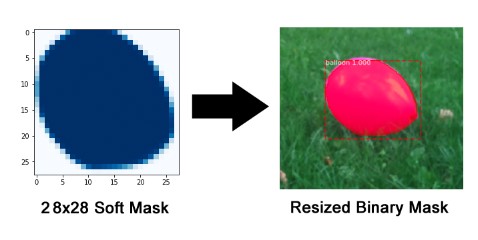
The mask branch is a convolutional network that takes the positive regions selected by the ROI classifier and generates masks for them. The generated masks are low resolution: 28x28 pixels. But they are soft masks, represented by float numbers, so they hold more details than binary masks. The small mask size helps keep the mask branch light. During training, we scale down the ground-truth masks to 28x28 to compute the loss, and during inferencing we scale up the predicted masks to the size of the ROI bounding box and that gives us the final masks, one per object.
Code Tip:
The mask branch is in build_fpn_mask_graph().
Let’s Build a Color Splash Filter

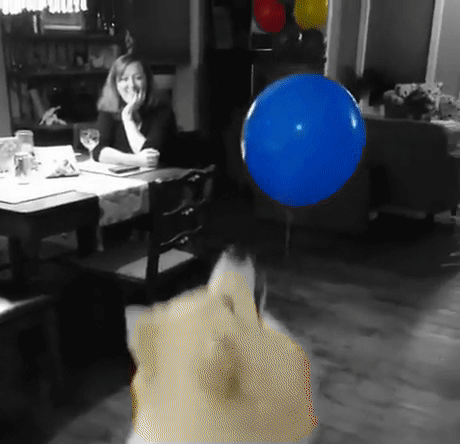
Unlike most image editing apps that include this filter, our filter will be a bit smarter: It finds the objects automatically. Which becomes even more useful if you want to apply it to videos rather than a single image.
Training Dataset
Typically, I’d start by searching for public datasets that contain the objects I need. But in this case, I wanted to document the full cycle and show how to build a dataset from scratch.
I searched for balloon images on flickr, limiting the license type to “Commercial use & mods allowed”. This returned more than enough images for my needs. I picked a total of 75 images and divided them into a training set and a validation set. Finding images is easy. Annotating them is the hard part.

Wait! Don’t we need, like, a million images to train a deep learning model? Sometimes you do, but often you don’t. I’m relying on two main points to reduce my training requirements significantly:
First, transfer learning. Which simply means that, instead of training a model from scratch, I start with a weights file that’s been trained on the COCO dataset (we provide that in the github repo). Although the COCO dataset does not contain a balloon class, it contains a lot of other images (~120K), so the trained weights have already learned a lot of the features common in natural images, which really helps. And, second, given the simple use case here, I’m not demanding high accuracy from this model, so the tiny dataset should suffice.
There are a lot of tools to annotate images. I ended up using VIA (VGG Image Annotator) because of its simplicity. It’s a single HTML file that you download and open in a browser. Annotating the first few images was very slow, but once I got used to the user interface, I was annotating at around an object a minute.
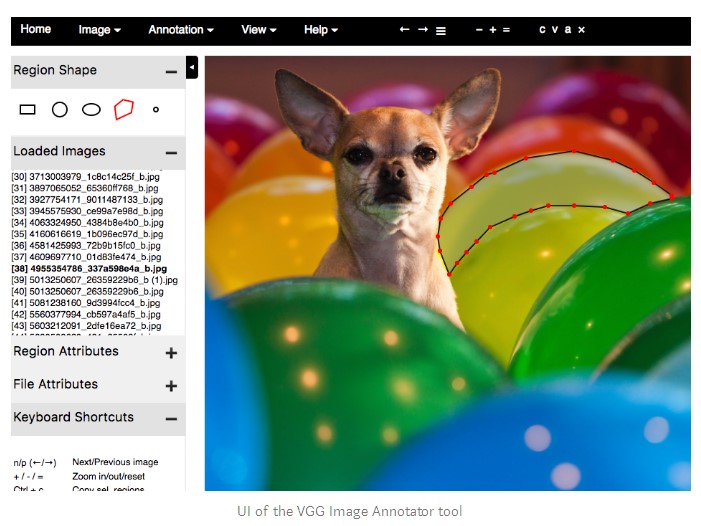
If you don’t like the VIA tool, here is a list of the other tools I tested:
- LabelMe: One of the most known tools. The UI was a bit too slow, though, especially when zooming in on large images.
- RectLabel: Simple and easy to work with. Mac only.
- LabelBox: Pretty good for larger labeling projects and has options for different types of labeling tasks.
- VGG Image Annotator (VIA): Fast, light, and really well designed. This is the one I ended up using.
- COCO UI: The tool used to annotate the COCO dataset.
Loading the Dataset
There isn’t a universally accepted format to store segmentation masks. Some datasets save them as PNG images, others store them as polygon points, and so on. To handle all these cases, our implementation provides a Dataset class that you inherit from and then override a few functions to read your data in whichever format it happens to be.
The VIA tool saves the annotations in a JSON file, and each mask is a set of polygon points. I didn’t find documentation for the format, but it’s pretty easy to figure out by looking at the generated JSON. I included comments in the code to explain how the parsing is done.
Code Tip:
An easy way to write code for a new dataset is to copy coco.py and modify it to your needs. Which is what I did. I saved the new file as balloons.py
My BalloonDataset class looks like this:
- class BalloonDataset(utils.Dataset):
- def load_balloons(self, dataset_dir, subset):
- ...
- def load_mask(self, image_id):
- ...
- def image_reference(self, image_id):
- ...
load_balloons reads the JSON file, extracts the annotations, and iteratively calls the internal add_class and add_image functions to build the dataset.
load_maskgenerates bitmap masks for every object in the image by drawing the polygons.
image_reference simply returns a string that identifies the image for debugging purposes. Here it simply returns the path of the image file.
You might have noticed that my class doesn’t contain functions to load images or return bounding boxes. The default load_image function in the base Dataset class handles loading images. And, bounding boxes are generated dynamically from the masks.
Code Tip:
Your dataset might not be in JSON. My BalloonDataset class reads JSON because that’s what the VIA tool generates. Don’t convert your dataset to a format similar to COCO or the VIA format. Insetad, write your own Dataset class to load whichever format your dataset comes in. See the samples and notice how each uses its own Dataset class.
Verify the Dataset
To verify that my new code is implemented correctly I added this Jupyter notebook. It loads the dataset, visualizes masks and bounding boxes, and visualizes the anchors to verify that my anchor sizes are a good fit for my object sizes. Here is an example of what you should expect to see:
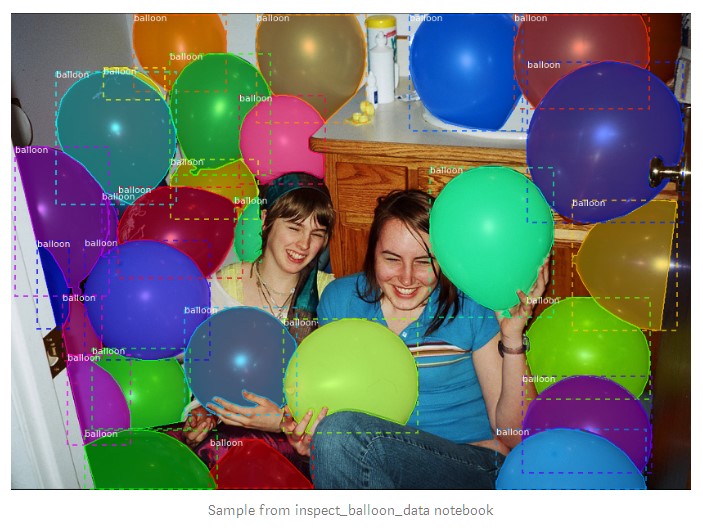
Code Tip:
To create this notebook I copied inspect_data.ipynb, which we wrote for the COCO dataset, and modified one block of code at the top to load the Balloons dataset instead.
Configurations
The configurations for this project are similar to the base configuration used to train the COCO dataset, so I just needed to override 3 values. As I did with the Dataset class, I inherit from the base Config class and add my overrides:
- class BalloonConfig(Config):
- # Give the configuration a recognizable name
- NAME = "balloons"
- # Number of classes (including background)
- NUM_CLASSES = 1 + 1 # Background + balloon
- # Number of training steps per epoch
- STEPS_PER_EPOCH = 100
The base configuration uses input images of size 1024x1024 px for best accuracy. I kept it that way. My images are a bit smaller, but the model resizes them automatically.
Code Tip:
The base Config class is in config.py. And BalloonConfig is inballoons.py.
Training
Mask R-CNN is a fairly large model. Especially that our implementation uses ResNet101 and FPN. So you need a modern GPU with 12GB of memory. It might work on less, but I haven’t tried. I used Amazon’s P2 instances to train this model, and given the small dataset, training takes less than an hour.
Start the training with this command, running from the balloon directory. Here, we’re specifying that training should start from the pre-trained COCO weights. The code will download the weights from our repository automatically:
- python3 balloon.py train --dataset=/path/to/dataset --model=coco
And to resume training if it stopped:
- python3 balloon.py train --dataset=/path/to/dataset --model=last
Code Tip:
In addition to balloons.py, the repository has three more examples: train_shapes.ipynb which trains a toy model to detect geometric shapes, coco.py which trains on the COCO dataset, and nucleus which segments nuclei in microscopy images.
Inspecting the Results
The inspect_balloon_model notebook shows the results generated by the trained model. Check the notebook for more visualizations and a step by step walk through the detection pipeline.
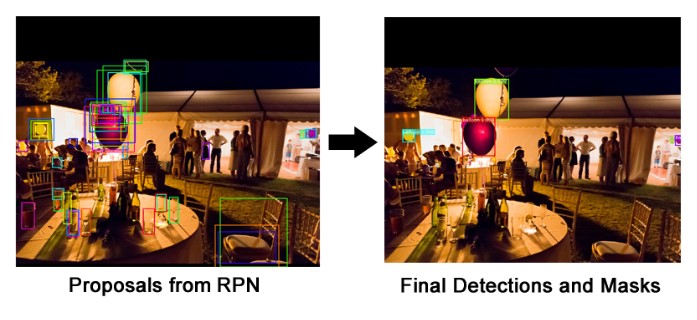
Code Tip:
This notebook is a simplified version of inspect_mode.ipynb, which includes visualizations and debugging code for the COCO dataset.
Color Splash
Finally, now that we have object masks, let’s use them to apply the color splash effect. The method is really simple: create a grayscale version of the image, and then, in areas marked by the object mask, copy back the color pixels from original image. Here is an example:
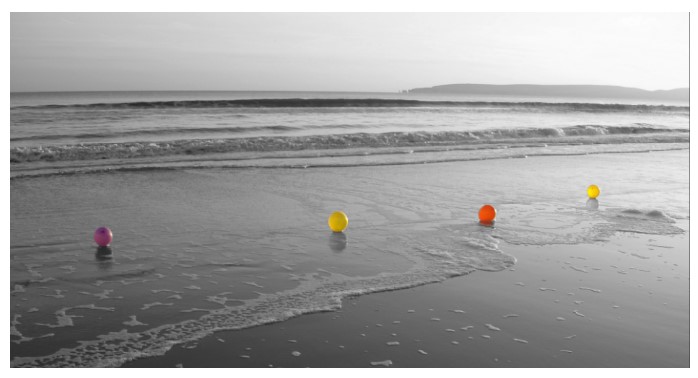
Code Tip:
The code that applies the effect is in the color_splash() function. And detect_and_color_splash() handles the whole process from loading the image, running instance segmentation, and applying the color splash filter.
FAQ
- Q: I want to dive deeper and understand the details, what should I read?
A: Read these papers in this order: RCNN (pdf), Fast RCNN, Faster RCNN, FPN, Mask RCNN. - Q: Where can I ask more questions?
A: The Issues page on GitHub is active, you can use it for questions, as well as to report issues. Remember to search closed issues as well in case your question has been answered already. - Q: Can I contribute to this project?
A: That would be great. Pull Requests are always welcome. - Q: Can I join your team and work on fun projects like this one?
A: Yes, we’re hiring for deep learning and computer vision. Apply here.
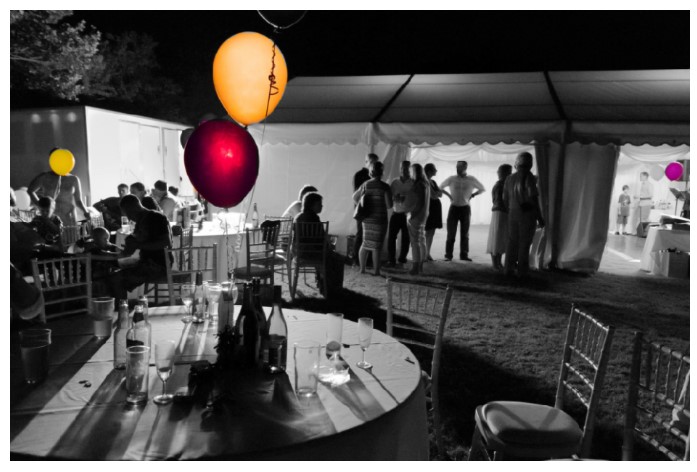
Instance Segmentation with Mask R-CNN and TensorFlow的更多相关文章
- 论文阅读笔记二十二:End-to-End Instance Segmentation with Recurrent Attention(CVPR2017)
论文源址:https://arxiv.org/abs/1605.09410 tensorflow 代码:https://github.com/renmengye/rec-attend-public 摘 ...
- Instance Segmentation入门总结
前一阵子好忙啊,好久没更新了.最近正好挖了新坑,来更新下.因为之前是做检测的,而目前课题顺道偏到了instance segmentation,这篇文章简单梳理一下从检测.分割结果到instance s ...
- 论文笔记:Dynamic Multimodal Instance Segmentation Guided by Natural Language Queries
Dynamic Multimodal Instance Segmentation Guided by Natural Language Queries 2018-09-18 09:58:50 Pape ...
- semantic segmentation 和instance segmentation
作者:周博磊链接:https://www.zhihu.com/question/51704852/answer/127120264来源:知乎著作权归作者所有,转载请联系作者获得授权. 图1. 这张图清 ...
- Rank & Sort Loss for Object Detection and Instance Segmentation 论文解读(含核心源码详解)
第一印象 Rank & Sort Loss for Object Detection and Instance Segmentation 这篇文章算是我读的 detection 文章里面比较难 ...
- 深度学习之卷积神经网络CNN及tensorflow代码实例
深度学习之卷积神经网络CNN及tensorflow代码实例 什么是卷积? 卷积的定义 从数学上讲,卷积就是一种运算,是我们学习高等数学之后,新接触的一种运算,因为涉及到积分.级数,所以看起来觉得很复杂 ...
- 深度学习之卷积神经网络CNN及tensorflow代码实现示例
深度学习之卷积神经网络CNN及tensorflow代码实现示例 2017年05月01日 13:28:21 cxmscb 阅读数 151413更多 分类专栏: 机器学习 深度学习 机器学习 版权声明 ...
- cnn汉字识别 tensorflow demo
# -*- coding: utf-8 -*- import tensorflow as tf import os import random import tensorflow.contrib.sl ...
- CVPR2020:三维实例分割与目标检测
CVPR2020:三维实例分割与目标检测 Joint 3D Instance Segmentation and Object Detection for Autonomous Driving 论文地址 ...
随机推荐
- nginx部署angular
官方部署教程 本文将angular官网的示例项目 heroes(英雄指南) 部署到nginx. 使用angular cli编译项目 ng build 执行完成后会生成一个 dist 目录. 服务器配置 ...
- Golang逃逸分析
Golang逃逸分析 介绍逃逸分析的概念,go怎么开启逃逸分析的log. 以下资料来自互联网,有错误之处,请一定告之. sheepbao 2017.06.10 什么是逃逸分析 wiki上的定义 In ...
- NVIDIA-docker Cheatsheet
TensorFlow Docker requirements Install Docker on your local host machine. For GPU support on Linux, ...
- scp 基本用法(提高scp传输速度)
Outline spc 可以帮你实现: Linux Server 之间互传数据: Linux Server 和 Windows Server 之间互传数据: 参考: https://www.cnblo ...
- 2019 美柚java面试笔试题 (含面试题解析)
本人5年开发经验.18年年底开始跑路找工作,在互联网寒冬下成功拿到阿里巴巴.今日头条.美柚等公司offer,岗位是Java后端开发,因为发展原因最终选择去了美柚,入职一年时间了,也成为了面试官,之 ...
- Vue3.0报错error: Unexpected console statement (no-console) 解决办法
写项目过程中用ESLint遵守代码规范很有必要,但是对于一些规范也很是无语,比如:‘Unexpected console statement (no-console)’,连console都不能用,这就 ...
- jQuery 前端复选框 全选 反选 下拉菜单联动
jQuery 页面中复选框全选.反选.下拉联动(级联) <!DOCTYPE html> <html lang="en"> <head> < ...
- 升级.net core 3.x 后mvc项目调试状态编辑view代码不能实时预览
https://stackoverflow.com/a/58126955 简单来说 需要在nuget上安装Microsoft.AspNetCore.Mvc.Razor.RuntimeCompilati ...
- MySQL--performance schema学习
启用performance schema 在MySQL 5.6.6版本后,performance schema被默认打开 通常MySQL的二进制版本都默认支持PS, 如果使用编译源码安装,在cmake ...
- Kali 安装tightvncserver
一.软件说明 a) tightvncserver是一个轻量级,只能建立桌面,不能查看TTY7/TTY1正在显示的桌面,但x11 vnc可以,相比x11vnc 安全传输差一些.反之,x11 vnc:安全 ...
